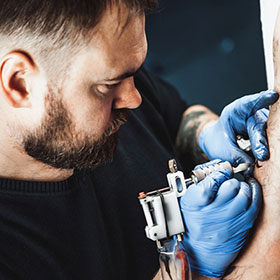Do chest tattoos hurt? Yes, they can be painful due to the area’s sensitivity.
Pain levels vary, but many feel discomfort during the process. Tattoos on the chest can be a bold statement. The skin is thinner and closer to the bone, which can make it more sensitive. Pain tolerance differs from person to person, so while some might find it bearable, others may struggle.
Knowing what to expect can help you prepare mentally and physically. We’ll explore the pain factors, tips to manage discomfort, and what you can do to ensure a smoother tattooing experience. Stay with us as we dive into the details of chest tattoos and pain management.
Introduction To Chest Tattoos
Chest tattoos have become very popular. Many people choose them for their unique look. These tattoos can be large or small. They can be simple or very detailed. The chest is a great place to show off art. It is also easy to cover if needed. This makes chest tattoos a good choice for many.
Chest tattoos are a trend. Celebrities and influencers have them. This makes them more popular. Social media shows many chest tattoo designs. People get inspired by these images. Friends and family may also influence the choice. Chest tattoos are now a common sight everywhere.
Picking the right design is important. Think about what you like. The design should have meaning. It can be a symbol or a picture. Some people choose words or quotes. Make sure the design fits well on the chest. Talk to the tattoo artist for advice. They can help you decide.
Pain Factors
Chest tattoos can be quite painful due to the lack of fat and muscle in the area. The skin on the chest is thin and sensitive, leading to higher discomfort levels.
Skin Sensitivity
Chest skin is very thin. Thin skin can feel pain more. There are many nerve endings. Nerve endings make the area very sensitive. This sensitivity increases pain. Bones are close to the skin. This makes tattooing more painful. If you have sensitive skin, you will feel more pain.
Tattoo Size And Detail
Large tattoos hurt more. They take longer to complete. Detailed designs also hurt more. Small tattoos hurt less. They take less time. Less detail means less pain. Choose a smaller design for less pain. Simple designs hurt less. Complex designs hurt more.
Tattooing Process
Getting ready for a tattoo is important. First, choose a design you love. Next, find a skilled tattoo artist. Clean the chest area well. Avoid alcohol and drugs before the session. Wear loose clothing for comfort. Eat a light meal to keep your energy up. Stay calm and relaxed.
The tattoo artist will clean the skin again. A stencil will be placed on your chest. The tattoo machine will start buzzing. Needles will pierce the skin quickly. You might feel a sharp or burning sensation. The pain can vary based on your tolerance. Take deep breaths to stay calm.
Pain Levels
The chest has different areas. Each area can hurt differently. Near the ribs can be very painful. The middle of the chest might hurt less. Closer to the shoulder usually feels the least pain. Under the collarbone can also be quite painful.
Pain tolerance varies from person to person. Some people feel less pain. Others might feel more. Mental state can affect pain levels. Staying calm helps. Good sleep and hydration can also lower pain.
Managing Pain
Eat well before your tattoo session. A full stomach can help you feel better. Try to rest well the night before. Good sleep helps your body handle pain. Avoid alcohol and caffeine. These can make pain feel worse. Wear loose clothes. This helps the tattoo artist work better.
Take deep breaths. This helps you stay calm. Tell the artist if you need a break. Short breaks can help you manage pain. Try to relax your muscles. Tense muscles can make pain feel worse. Listening to music can help distract you. Bring headphones if you like.
Follow the artist’s care instructions. This helps your skin heal better. Keep the area clean and dry. Avoid touching it with dirty hands. Apply a healing ointment if advised. This can reduce pain and swelling. Avoid direct sunlight on your new tattoo. Sun can irritate the skin.
Common Experiences
Many people say chest tattoos hurt. The skin is thin. Bones are near the surface. Pain can vary from person to person. Some feel a sharp sting. Others describe it as a burning sensation. Taking breaks helps. Deep breaths can also make it more bearable.
Some think chest tattoos hurt less than other tattoos. This is not true. The chest has many nerve endings. This can make the pain intense. Also, some believe all tattoos feel the same. They don’t. Pain levels can change based on location. The chest is one of the more painful areas.
Professional Advice
Choosing the right tattoo artist is very important. A good artist will make the process easier. They must have experience and skill. Check their portfolio before you decide. Look at their past work. This will help you understand their style.
Read reviews from other clients. Good reviews mean happy customers. Bad reviews are a warning sign. Always trust your instincts. If you feel uneasy, look for another artist. Your comfort is key to a good experience.
A consultation with your artist is important. Discuss your design ideas. Talk about any concerns you have. Ask about the process. This will help set your expectations. You will know what to expect.
Ask how long the session will take. Knowing this helps you plan your day. Clear communication is key. It ensures you and the artist are on the same page. This leads to a better tattoo experience.
Conclusion
Chest tattoos can be painful, but the pain varies for everyone. Pain depends on factors like size, design, and your pain tolerance. Many find the result worth the discomfort. It’s vital to choose a skilled artist for a safe experience.
Proper aftercare helps in healing and reducing pain. Remember, pain is temporary, but your tattoo is forever. Consider your choices and be prepared. Chest tattoos are a big commitment. Ensure you are ready for it.

